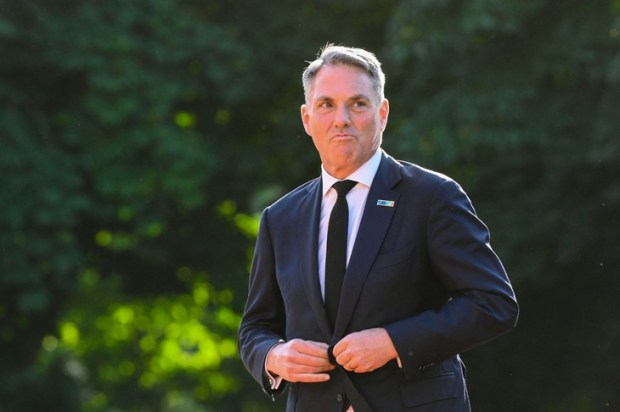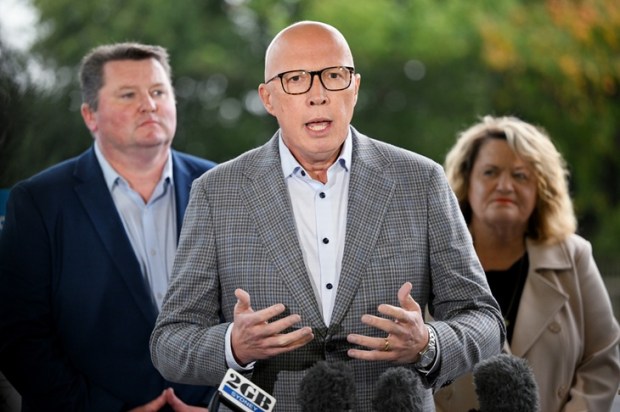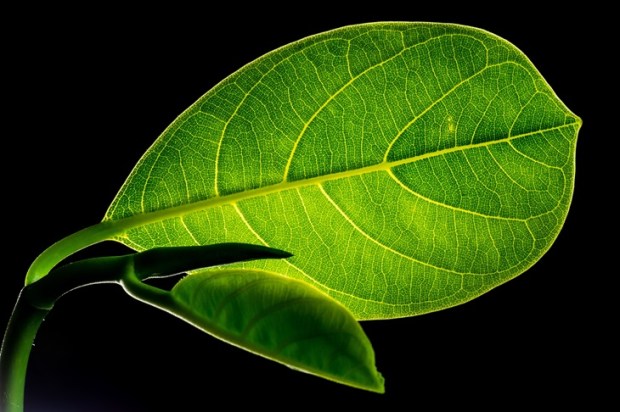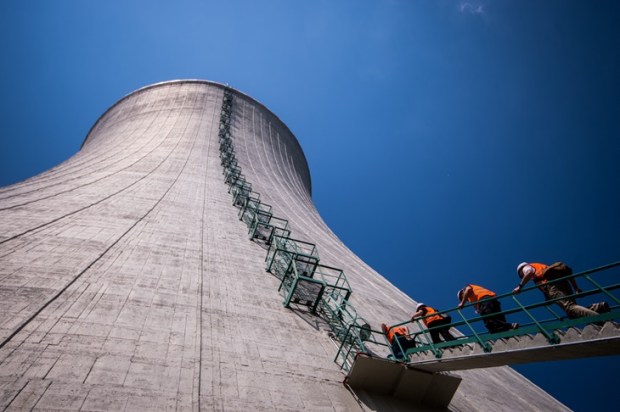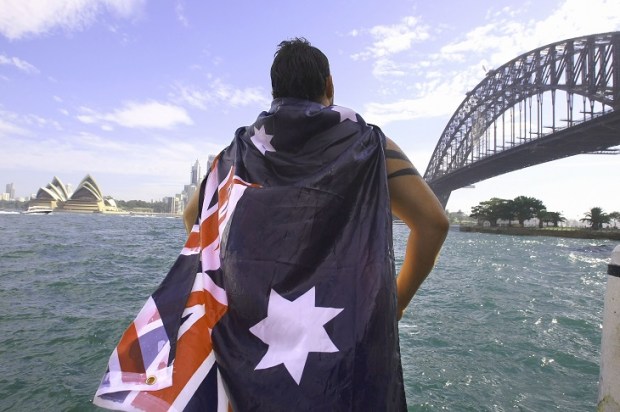On Sunday, July 28, I was asked to speak at the ‘Rally to Oppose the Illawarra Offshore Wind Proposal’ in Lake Illawarra.
The two-hour drive from the Northern Beaches of Sydney was well worth it to support a community that feels abandoned and unconsulted by its local Labor Members and the Federal Labor government.
The Illawarra Offshore Wind project is confronting. The size of the project boggles the mind. It is admitted on the Department of Climate Change, Energy, the Environment and Water website, that the declared maximum area will be 1,022km².
It is worth repeating, the Illawarra Offshore Wind project will have an area of 1,022km².
To put that into context, Singapore is 736km² and New York City is 790km².
It will stretch from Wombarra in the north to Kiama in the south, including Wollongong, Port Kembla, and Shellharbour.
It will sit at least 20km offshore, with over 200 turbines standing 260 metres tall.
At its shortest length, it will sit 26km from Cronulla Beach, which faces the project, and roughly 35km to 37km from Bondi.
To put it into perspective, Parramatta is roughly 25km from Sydney Tower, which is clearly visible with a line of sight. On the Sydney Tower website, it claims that from the Observation Deck (250 metres high), you can see the Blue Mountains on a clear day, which are 80km away.
Yet, the government is claiming that the wind turbines will be hard to see from the Illawarra Coast; going to the effort of creating visualisations of how the constructed wind turbines will look.
The Illawarra Community are no mugs, however, and have called out the government for the visualisations on the Department’s website, alleging the images are not true representations. Rightly, in my view, the community point out that the opacity of the turbines were reduced to make them see-through and as a result, harder to see in the images.
Beyond the aesthetics of the project, the community have expressed grave concerns, highlighting that the current world’s largest floating offshore wind project has only 11 turbines – a far cry from over 200.
Locals are also expressing environmental concerns, as the project crosses whale migration routes, seabird paths, shipping lanes, and fishing zones.
The concerns are not unfounded, with Environmental Policy Advocate, Michael Shellenberger, writing last year in the New York Post, said: ‘There have been more than 60 recorded whale deaths of all species on the East Coast (of America) since Dec 1, 2022, a number that increased markedly since 2016 when the wind industry started to ramp up.’
Shellenberger was the executive producer of, ‘Thrown to the Wind’, in which he says the documentary ‘proves building offshore wind farms does kill whales’.
Of course, there are also concerns about the potential price tag, flawed claims of community consultation and the toxic chemicals and oils included in the turbines themselves.
Unfortunately, the Illawarra offshore wind project is only one of many large-scale industrial wind and solar projects happening in Australia under the climate ‘leadership’ of Minister Chris Bowen.
Port Stephens will see an offshore wind project with a declared area of 1,854km². The Southern Ocean in Victoria will be 1,030km².
If you think that is bad, it only gets worse.
Off the Bunbury Region in Western Australia the offshore wind project has a proposed area of 7,674km². Larger still is the project in the Bass Strait, proposed to be 10,136km².
The Big Kahuna and most mind-bending project of all will be Gippsland in Victoria. The offshore wind project has a declared area of 15,000km².
To put it into perspective, Vanuatu is 12,189km², Timor-Leste (East Timor) is 14,874km².
Do everyday voters realise the scale of these projects?
Who will build them? Where will the expertise come from? Where will the components come from?
Importantly, where will the money come from? We know the answer to that – taxpayer subsidies. That is, younger generations who will spend their working lives paying for the growing debt and inflation these projects bring.
It is no better on land.
The New South Wales government is well underway in its plan to build five Renewable Energy Zones (REZ) in the State, including New England, South West, Hunter-Central Coast and Illawarra.
Specifically, the Central-West Orana REZ will take up 20,000km² of land encompassing the towns of Dubbo, Dunedoo, Gilgandra, Coolah, Mudgee, and Wellington.
Grant Piper, the Chairman of the National Rational Energy Network (NREN), has been painstakingly reading through each proposal within the Central-West Orana REZ and has currently tallied over 1,000 wind turbines and over 9 million solar panels.
Forget being energy independent.
Instead of harnessing the coal, gas, uranium, and even thorium, that we have an abundance of, we are importing overseas components that are largely built by overseas companies.
This reckless rollout of these projects is making us energy dependent on the rest of the world, particularly China who has a stranglehold on 80 per cent of solar panel manufacturing.
Then there is the hypocrisy.
Climate Change and Energy Minister, Chris Bowen (McMahon), Environment and Energy Minister, Tanya Plibersek (Sydney), Prime Minister Anthony Albanese (Grayndler) are all in Sydney electorates.
Then there are the Sydney Teals, Dr. Sophie Scamps (Mackellar), Zali Steggall (Warringah), Kylea Tink (North Sydney), Allegra Spender (Wentworth).
Melbourne is no better with Teal Monique Ryan (Kooyong) and Greens Adam Bandt (Melbourne).
Where are the large-scale, renewable projects being built in Sydney or Melbourne?
On Sophie Scamp’s Instagram page, she has a video of her dancing along a beach in Mackellar, advocating for wind and solar projects.
But where is the 1,000km² offshore wind project off the coast of Mackellar?
It is worse on Zali Steggall’s website. On the page ‘Where does Zali stand on…’, Zali states, ‘I do not support wind farms along Warringah’s beachfront.’
Why not?
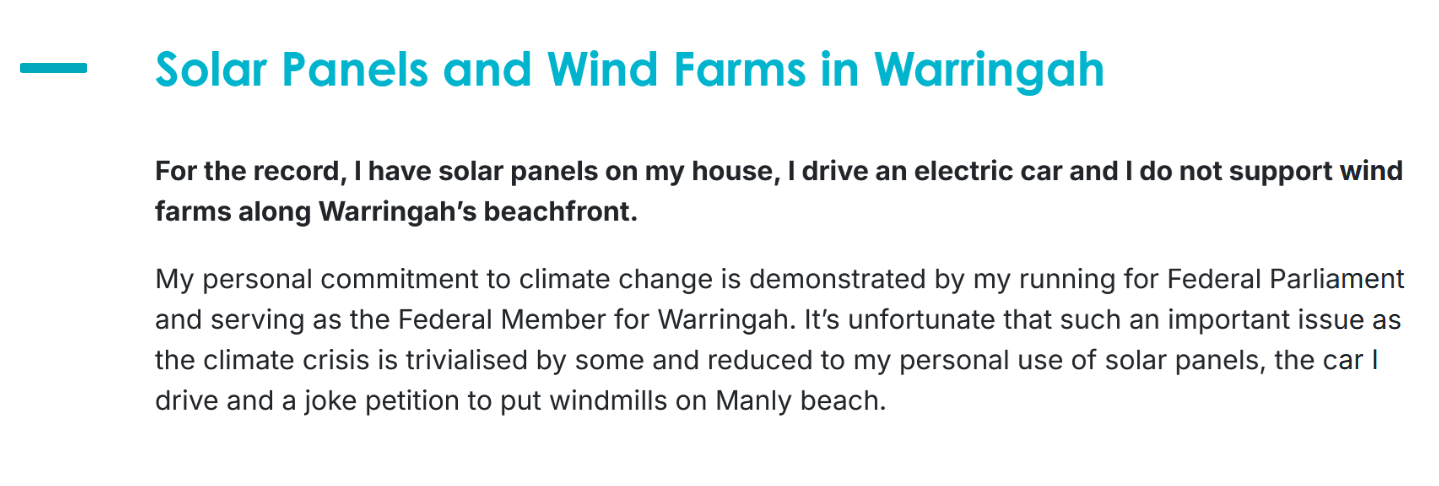
Her policy platform proclaims ‘climate leadership’, and she commits to an ‘orderly transition to 80 per cent renewable energy by 2030’.
But of course, this transition to ‘renewables’ cannot take place in her backyard.
Steggall states on her site, ‘It’s unfortunate that such an important issue as the climate crisis is trivialised by some and reduced to my personal use of solar panels, the car I drive and a joke petition to put windmills on Manly beach’.
It may be a joke for Zali Steggall, but it is not a joke for the rural and regional communities that face the impact of these industrial renewable projects being recklessly rolled out throughout the country.
Not to mention the new high-voltage transmission lines that need to cross through agricultural, grazing or bushland to get to these projects.
Thankfully, we have communities like the Illawarra and elsewhere, who are doing everything they can to push back against these projects. Some communities are successful, others not.
What is clear is that more people, particularly in our major cities, need to wake up to the reckless rollout of these unaffordable, unreliable, environmentally destructive, intermittent energy projects (otherwise known as ‘renewables’) and the scale in which they are transforming our country.
By Steven Tripp


